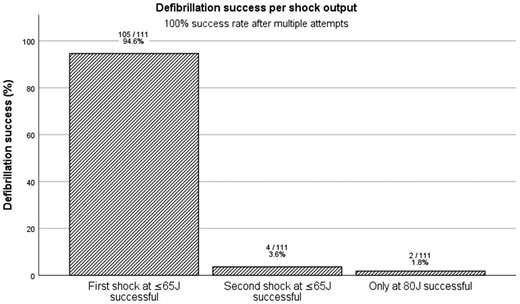-
PDF
- Split View
-
Views
-
Cite
Cite
W Van Der Stuijt, S Pepplinkhuizen, ABE Quast, L Smeding, LRA Olde Nordkamp, AAM Wilde, RE Knops, Defibrillation success after subcutaneous implantable cardioverter-defibrillator generator replacement is not affected by impedance increase, EP Europace, Volume 23, Issue Supplement_3, May 2021, euab116.416, https://doi.org/10.1093/europace/euab116.416
Close - Share Icon Share
Abstract
Type of funding sources: None.
Routine defibrillation testing during implant and replacement of the subcutaneous implantable cardioverter-defibrillator (S-ICD) is recommended per current guidelines. Recently, concerns have been raised about an increase in shock impedance and consequent shock failure during defibrillation testing in S-ICD patients undergoing a generator replacement.
We aim to describe the defibrillation success rate in relation to the shock impedance in patients undergoing S-ICD generator replacement in our large tertiary center.
In this retrospective analysis, data from replacement procedures were collected from all patients who underwent an S-ICD generator replacement in our center from June 2014 to December 2020. Defibrillation testing was performed with at least one shock of ≤65J, and a successful shock was defined as terminating the ventricular arrhythmia within 5 seconds after the shock.
A total of 133 patients underwent an S-ICD generator replacement, 5.8 ± 0.9 years after initial implant. Reasons for replacement were: reaching of elective replacement indicator (n = 119), early battery depletion (n = 9), complaints of generator pocket (n = 3) and device malfunction (n = 2). Defibrillation testing was performed in 111 patients (86.5%) undergoing a replacement procedure. Shock impedance data from both the implant and replacement procedure were available in 101 patients. The median shock impedance of these patients during their replacement procedure was significantly higher than during their implant, 79Ω (IQR 66-94) and 66Ω (IQR 57.5-81) respectively (Z = -5.552, p < 0.001). Despite the higher shock impedance, first shock during defibrillation testing was successful in 105/111 patients (94.6%), with a success rate of 97.3% after two attempts. In the remaining three patients, the ventricular arrhythmia could only be terminated with a 80J shock. This was the case during both their initial implant and their replacement procedure. Shock impedance increase between implant and replacement was not significantly higher in patients with a successful first shock compared to patients with an unsuccessful first shock (Δ+11.1 ± 20.0Ω versus Δ+12.7 ± 27.6Ω, p = 0.86).

Abstract Figure. Defibrillation success



